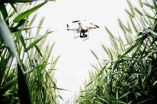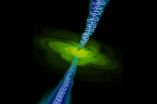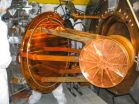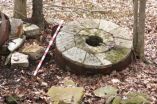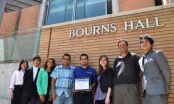(Press-News.org) CHAMPAIGN, Ill. — This growing season, crop researchers at the University of Illinois are experimenting with the use of drones – unmanned aerial vehicles – on the university's South Farms.
Dennis Bowman, a crop sciences educator with U. of I. Extension, is using two drones to take aerial pictures of crops growing in research plots on the farms. He presented his findings to farmers and other researchers at the 2014 Ford / Iroquois County Agronomy Day meeting.
Bowman intentionally made mistakes on one test plot – "areas where we didn't apply enough nitrogen fertilizer, where we simulated mistakes in the applicator, where we shut the boom off for a short period of time or plugged it up and ran for a while," Bowman said. "As the crop gets up and going, we'll fly over it and see if we can detect those areas sooner than we could visually from the ground. (Watch the drone in action.)
"We're also looking at doing some scans over our herbicide studies to see if the drone photography can help us identify where crops are stressed by postemergence herbicide applications."
For farmers, aerial photographs taken by drones offer a quick and easy way to check on the progress of crops and determine where they may need to replant or direct pesticide applications.
"I spent two summers as a commercial crop scout before I went into Extension, and walking through tasseling corn in the heat of summer is not a pleasant task," Bowman said. "The odds of actually getting to the far end of that field on foot to see what's going on are pretty slim. To get a bird's-eye view of your crop, the drones offer a handy way to do it."
Both drones Bowman is using are multirotor helicopters, or quadricopters. Bowman bought the first drone last fall. It's a remote-controlled Phantom, manufactured by the company DJI. This spring, he bought a second aircraft, an A.R. Drone 2.0 with GPS produced by the French wireless electronics manufacturer Parrot.
Using rechargeable lithium polymer batteries, each drone can make flights of about 10 to 15 minutes. The computers in the drones are similar to those used in smartphones.
The Phantom, which cost about $500, was a ready-to-fly model equipped with a mount for a GoPro camera. With the addition of the mount, a camera and a gimbal to keep the camera level, Bowman's total investment was about $1,000.
When the Phantom is turned on, its computer starts the GPS, and the flight control system runs through a one- to two-minute process of locating and locking on to GPS satellites to establish the drone's home position. If launched properly by allowing the flight control system to orient itself with the satellites, the Phantom drone will return to within 1 meter of its home position when the operator turns the transmitter off.
The Parrot drone, which cost about $250, can be controlled with a smartphone or tablet using Apple or Android operating systems and Wi-Fi signals. The Parrot came with a protective polystyrene hull for use indoors, and Bowman has demonstrated it during meetings with area farmers.
"When I'm running the Parrot drone during a conference, I pick somebody that looks scared when I pull it out, and I take the iPad over to them and tell them I'm going to have them launch it for me," Bowman said. "You press the screen where it says 'take off' and the drone pops up 3 feet in the air, hovers and waits for you to take over flying it."
"Standard pictures and video taken with drones can tell us a lot," Bowman said. "But what we're looking to give us even more information is multispectral cameras that can give us imagery in other wavelengths, such as near-infrared, to help us identify areas of crop stress. It probably isn't going to tell us what the problem is, but it will tell us where problems are so that we can target our scouting in those specific areas and determine what might be occurring."
Bowman has a Canon Powershot SX260 camera that has been modified and equipped with an upgraded lens for infrared photography, which will help the researchers identify plants in the South Farms' plots that appear to be absorbing or reflecting light differently, an indication that the plants are under some type of stress, such as pests, disease or nutrient deficiencies.
The drones also may be deployed in the battle against Palmer amaranth, an invasive weed that is spreading across the Midwest and has been found on the South Farms. Palmer amaranth is becoming increasingly resistant to herbicides and spreads so prolifically that it could drastically reduce farmers' yield potential in affected fields.
"Before the soybean rows close, or if we get a different spectrum response from some of these weeds as they break through the canopy, we may see some of those weeds show up in the imagery as well to identify where there are hot spots and problems," Bowman said.
Commercial use of unmanned aerial vehicles in U.S. airspace was banned by the Federal Aviation Administration in 2007, although growing numbers of hobbyists have been toying with the use of drones, particularly for aerial photography.
However, facing mounting pressure from agribusiness, retail and other industries, the FAA is expected to release new policies by 2015 that will enable businesses to integrate drones into their operations. The agriculture industry is expected to be one of the largest market segments for drone usage.
"If the FAA rules come through, and the price of the technology comes down, it doesn't seem all that far-fetched to me to think that not too far in the future a farmer will get up in the morning, hit a button and launch a couple drones that fly out over his farms and collect imagery that's sent wirelessly to his office," Bowman said. "And one of the first things he could do at the beginning of the day is sit down and scan his fields to see if anything has happened that needs his attention."
INFORMATION:
Editor's note: To reach Dennis Bowman, call 217-244-0851; email: ndbowman@illinois.edu.
Drones give farmers an eye in the sky to check on crop progress
2014-06-04
ELSE PRESS RELEASES FROM THIS DATE:
Increase in number of total knee replacement surgeries, especially in younger adults, linked to obesity
2014-06-04
ROSEMONT, Ill.─The number of total knee replacement (TKR) surgeries more than tripled between 1993 and 2009, while the number of total hip replacements (THR) doubled during the same time period. A study appearing in the June Journal of Bone and Joint Surgery (JBJS) found that an increase in the prevalence of ovrweight and obesity in the U.S. accounted for 95 percent of the higher demand for knee replacements, with younger patients affected to a greater degree.
"We observed that growth of knee replacement volumes was far outpacing that of hip replacements and were ...
Surprisingly strong magnetic fields challenge black holes' pull
2014-06-04
A new study of supermassive black holes at the centers of galaxies has found magnetic fields play an impressive role in the systems' dynamics. In fact, in dozens of black holes surveyed, the magnetic field strength matched the force produced by the black holes' powerful gravitational pull, says a team of scientists from the U.S. Department of Energy's Lawrence Berkeley National Laboratory (Berkeley Lab) and Max Planck Institute for Radio Astronomy (MPIfR) in Bonn, Germany. The findings are published in this week's issue of Nature.
"This paper for the first time systematically ...
No evidence of the double nature of neutrinos
2014-06-04
Neutrinos are tiny, neutral elementary particles that, contrary to the standard model of physics, have been proven to have mass. One possible explanation for this mass could be that neutrinos are their own antiparticles, so-called Majorana particles.
Though experimental evidence for this is still lacking, many theoretical extensions of the standard model of physics predict the Majorana nature of neutrinos. If this hypothesis proves to be true, many previously unanswered questions about the origin of our universe and the origin of matter could be answered.
650 meters ...
NASA sees Depression Boris mOVING over Mexico with heavy rainfall
2014-06-04
Tropical Depression 2E strengthened into Tropical Storm Boris briefly on June 3 before making landfall in southern Mexico and weakening into a depression. While Boris was building to tropical storm strength, NASA's Aqua and TRMM satellites passed overhead identifying heavy rainfall and the extent of the storm.
On June 3 at 19:15 UTC (3:15 p.m. EDT) the Moderate Resolution Imaging Spectroradiometer (MODIS) instrument aboard NASA's Aqua satellite captured a visible image of Tropical Storm Boris over Central America. Boris appeared circular in the imagery and its clouds ...
Scientist uses fossils to prove historic Ohio millstones have French origins
2014-06-04
Cleveland . . . A geologist studied fossils to confirm that stones used in 19th century Ohio grain mills originated from France. Fossils embedded in these millstones were analyzed to determine that stones known as French buhr were imported from regions near Paris, France, to Ohio in the United States.
Dr. Joseph Hannibal, curator of invertebrate paleontology at The Cleveland Museum of Natural History, was lead author on research published in the Society for Sedimentary Geology journal PALAIOS.
The study documents a technique that uses fossils to definitively distinguish ...
Cleaning the air with roof tiles
2014-06-04
RIVERSIDE, Calif. (http://www.ucr.edu) — A team of University of California, Riverside's Bourns College of Engineering students created a roof tile coating that when applied to an average-sized residential roof breaks down the same amount of smog-causing nitrogen oxides per year as a car driven 11,000 miles.
They calculated 21 tons of nitrogen oxides would be eliminated daily if tiles on one million roofs were coated with their titanium dioxide mixture. They also calculated it would cost only about $5 for enough titanium dioxide to coat an average-sized residential roof.
That ...
Mayo Clinic researchers decode how the brain miswires, possibly causing ADHD
2014-06-04
JACKSONVILLE, Fla. — Neuroscientists at Mayo Clinic in Florida and at Aarhus University in Denmark have shed light on why neurons in the brain's reward system can be miswired, potentially contributing to disorders such as attention deficit hyperactivity disorder (ADHD).
They say findings from their study, published online today in Neuron, may increase the understanding of underlying causes of ADHD, potentially facilitating the development of more individualized treatment strategies.
The scientists looked at dopaminergic neurons, which regulate pleasure, motivation, ...
GW Cancer Institute conducts survey on moving toward quality patient-centered care
2014-06-04
WASHINGTON (June 4, 2014) — In order to meet new cancer program accreditation standards, institutions have placed new focus on patient navigation, psychosocial distress screening, and survivorship care plans. Recently published research by the George Washington University (GW) Cancer Institute found these new programs are experiencing "growing pains." The results of a nationwide survey conducted by the GW Cancer Institute and reviewed in the Journal of Oncology Navigation and Survivorship, found that health care professionals could most benefit from greater evaluation of ...
Hemorrhagic fevers can be caused by body's antiviral interferon response
2014-06-04
LA JOLLA, CA—June 4, 2014— Hemorrhagic fevers caused by Lassa, dengue and other viruses affect more than one million people annually and are often fatal, yet scientists have never understood why only some virus-infected people come down with the disease and others do not.
But now, virologists and immunologists at The Scripps Research Institute (TSRI) have found a major clue to the mystery of "hemorrhagic fever" syndromes. In findings reported this week in an Early Edition of the Proceedings of the National Academy of Sciences, the team showed that Interferon Type I (IFN-I) ...
Astronomers discover first Thorne-Zytkow object, a bizarre type of hybrid star
2014-06-04
In a discovery decades in the making, scientists have detected the first of a "theoretical" class of stars first proposed in 1975 by physicist Kip Thorne and astronomer Anna Żytkow. Thorne-Żytkow objects (TŻOs) are hybrids of red supergiant and neutron stars that superficially resemble normal red supergiants, such as Betelguese in the constellation Orion. They differ, however, in their distinct chemical signatures that result from unique activity in their stellar interiors.
TŻOs are thought to be formed by the interaction of two massive stars―a ...
